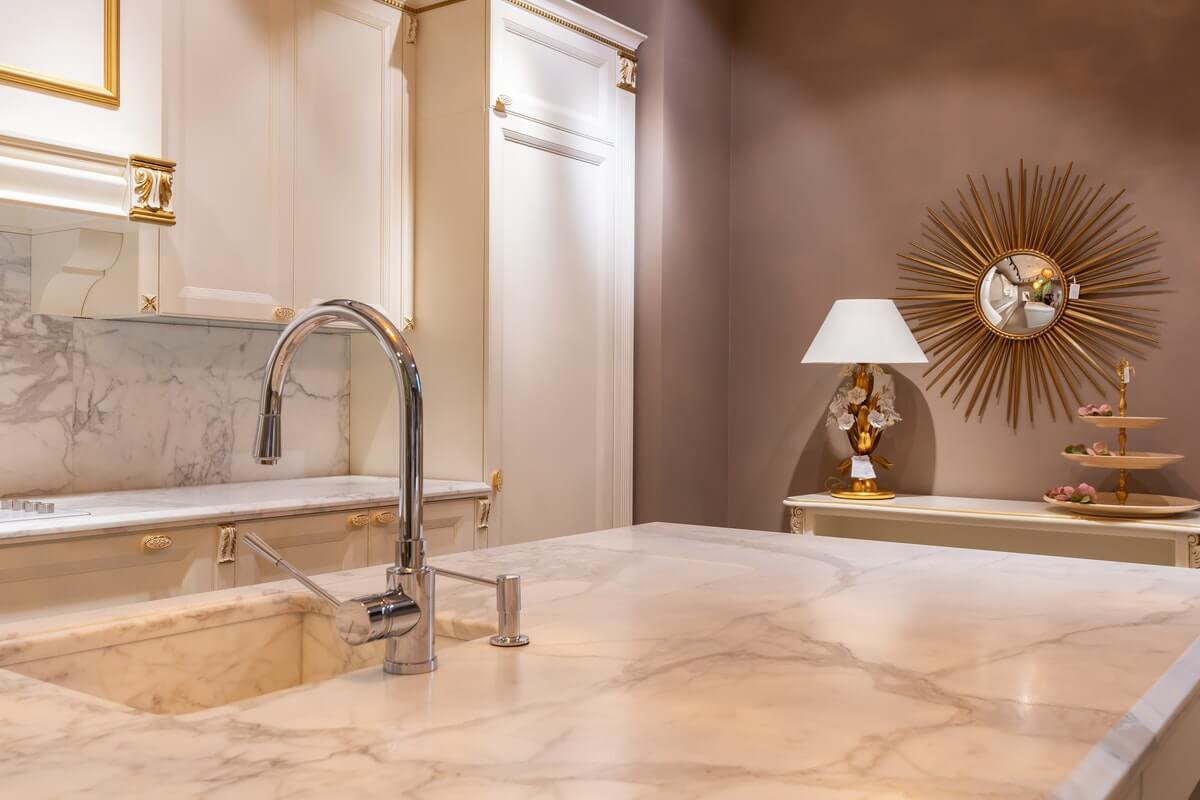HOW TO CHOOSE A KITCHEN WORKTOP: ALL YOU NEED TO KNOW

Worktops are one of the most essential aspects of any kitchen, yet they must also be functional. Choose from natural, modern, and inventive materials that may be used alone or combined to create a unique look and enhanced performance.
Here, we take a further look at six of the most popular materials – porcelain, stone, composite quartz, laminate, solid surface, and wood – providing professional advice on how to utilize it, why to use it, and the top firms to check out.
Large-format porcelain slabs are both sturdy and lightweight, scratch-proof, stain-proof, antibacterial, and can even be used with hot pans without scorching. Any material from concrete to metal to stone may be replicated; colours stay constant over time.
‘Advances in digital printing can produce “natural” variations from tile to tile, making it seem identical to the real thing,’ according to Jo Oliver, director of Stone & Ceramic Warehouse. ‘This makes it possible for you to get the appearance you desire at a lower price and without the difficulties and maintenance concerns that come with
How to use
The stone must be installed by an expert. With huge slabs, weight and access may be issued, so keep that in mind. Most stone is sealed before installation, and chopping boards should be used to prevent knives as well as the surface itself.
COMPOSITE QUARTZ
Composite quartz, often known as engineered stone, is a super-tough solid slab made by combining a high percentage of ground quartz crystals with recycled glass, resins, polymers, and colours to create an ecologically friendly material. It may be moulded to resemble natural stones like granite and marble and comes in a variety of finishes.
‘Quartz is highly durable, non-porous and crack-resistant, so it does not require sealing,’ according to Caesarstone’s Jon Stanley.
How to use
Quartz is cut, shaped, and installed by a fabricator. To create a monolithic look, worktops may be formed with ornamental edges, mitred joints can enhance deeper surfaces, and kitchen islands may be wrapped in the substance to form a single surface. Quartz is low-maintenance and may be used as cladding or flooring.
LAMINATE
Laminate is a compact, dense surface developed from compressed layers of paper and resin bonded to a chipboard core. ‘Designs have advanced considerably, with an abundance of contemporary plain, patterned, and realistic finishes such as wood, concrete, and stone now available that offer the look of the material without the maintenance hassles,’ says Caroline
Edges are formed post-hoc, which means there are no places where dirt can build up. Laminate is also scratch-resistant, heatproof, and impact-resistant.
How to use
Laminates are an excellent choice for any kitchen since they are easier to transport and cut than most other materials. To bind the design together, most companies include matching upstands and splashbacks with the installation.
SOLID SURFACE
A smooth, tactile product is produced from minerals, acrylic polymer, and natural pigments when they are combined into a solid surface.
The non-porous, hygienic, mould-free, and virtually limitless colour palette of worktops includes solid hues, natural stone patterns, and even translucent tints that may be backlit to create a soft glow. Small scratches can be polished away with an abrasive cleaner and although heat-resistant trivets are advised when using hot pans, they are not required.
How to use
This material may be moulded into curving edges, fitted with sinks and splashbacks, and linked to form a visually continuous expanse thanks to its flexibility. It must be handled by skilled contractors because it is similar to wood in that it can be sawn, routed, drilled, sanded, etched, and utilized as wall-cladding on horizontal surfaces.
WOOD
A sustainably sourced wood worktop adds timeless appeal to a kitchen and will develop an appealing patina as it ages and its natural colour deepens. Wood is also kinder on dishes and has gentler acoustics than harder materials. Choose from a variety of species, including oak, walnut, iroko, maple, ash, Sapele, and cherry, to mention a few.
How to use
Wood is simple to set up, but it requires the assistance of an expert fitter for a good outcome. It’s a good idea to oil the surface on a regular basis, although stains will be repelled as long as spills are wiped immediately, and scratches and marks may be sanded out. In particularly wet areas such as around a sink, timber should be avoided.
Looking for your next kitchen worktop? Why not contact Eurostone? Eurostone is a family-owned and runs business and they have been in the kitchen worktop industry for over 30 years. They supply and fit Kitchen worktops, Bathroom worktops and Vanity tops across the UK.








